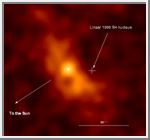|
COMETS EARTH JUPITER KUIPER BELT MARS MERCURY METEORITES NEPTUNE OORT CLOUD PLUTO SATURN SOLAR SYSTEM SPACE SUN URANUS VENUS ORDER PRINTS
PHOTO CATEGORIES SCIENCEVIEWS AMERICAN INDIAN AMPHIBIANS BIRDS BUGS FINE ART FOSSILS THE ISLANDS HISTORICAL PHOTOS MAMMALS OTHER PARKS PLANTS RELIGIOUS REPTILES SCIENCEVIEWS PRINTS
|
Related Document
Download Options
X-rays from Comet C/1999 S4 (LINEAR). On July 14, 2000 the Chandra X-ray Observatory imaged the comet repeatedly for a total of 2 1/2 hours and detected X-rays from oxygen and nitrogen ions. The details of the X-ray emission, as recorded on Chandra's Advanced CCD Imaging Spectrometer, show that the X-rays are produced by collisions of ions racing away from the sun (solar wind) with gas in the comet. In the collision the solar ion captures an electron from a cometary atom into a high energy state. The solar ion then kicks out an X-ray as the electron drops to a lower energy state. The Chandra observations showed variations in the amount of X-rays produced by the comet. These were probably due to a solar flare that occurred on July 12 which would have increased the intensity of the solar wind. Previously, several models had been proposed to explain how comets could produce X-rays. The Chandra observation of C/1999 S4 proves the model described above. Now it is possible to study the chemistry of the solar wind, and the structure of the comet's atmosphere. The colors represent the intensity of the X-rays with white being the most intense, then yellow, orange, and red. |
